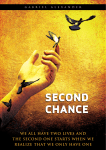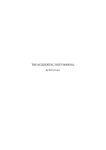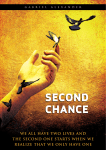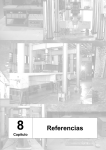Download CLARITY The Mental Body (Manas)
Transcript
065-146_LightLife_ch3,4prep 8/18/05 1:12 PM Page 107 Sirsasana Chapter 4 CLARITY The Mental Body (Manas) Y ou cannot hope to experience inner peace or freedom without understanding the workings of your mind and of human conscious- ness in general. All behavior, both constructive and destructive, is dependent on our thoughts. By understanding how our thinking works, we discover nothing less than the very secrets of human psychology. With this right perception and understanding of our minds, the door opens to our liberation, as we go through the veil of illusion into the bright day of clarity and wisdom. The study of mind and consciousness, therefore, lies at the heart of yoga. Obviously mind and consciousness are involved at every level of our being, but because of their subtlety they are considered to reside, 107 065-146_LightLife_ch3,4prep 8/18/05 1:12 PM Page 108 as far as yoga’s blueprint of humanity is concerned, in the third and fourth sheaths of being. The yogi makes a distinction between the mental body (manomaya kosa), where the incessant thoughts of human life occur, and the intellectual body (vijnanamaya kosa), where intelligence and discernment can be found. This chapter deals in detail with the mental body and how the thinking brain, memory, ego, and sensory perception work together, for good or for ill, in our lives. I will introduce the yogic definition of intelligence—making self-aware choices through informed discernment and the exercise of will—but I will return to intelligence and wisdom in the next chapter. It is through this intelligence that we initiate change and free ourselves from ingrained patterns of behavior and steer ourselves incrementally toward illumination and freedom. However, we can hope only to develop intelligence once we understand why we are so often prompted to act without it. Patanjali, in his Yoga Sutras, chose to make the workings of mind and consciousness, both in success and in failure, the central theme of yoga philosophy and practice. In fact, from the yogi’s standpoint, practice and philosophy are inseparable. Patanjali’s first sutra says, “Now I’m going to present the disciplined code of ethical conduct, which is yoga.” In other words, yoga is something you do. So what do you do? The second sutra tells us, “Yoga is the process of stilling the movements and fluctuations of mind that disturb our consciousness.” Everything we do in yoga is concerned with achieving this incredibly difficult task. If we achieve it, Patanjali said, the goal and the fruit of yoga will be within our grasp. My life’s work has been to demonstrate that from one’s very first Samasthiti (standing still and straight) or Tadasana (mountain pose) in one’s very first class, one is embarking on this task. If one perseveres and refines, gaining strength and clarity, always penetrating from the initial practice, then the techniques of body and breath that yoga offers will lead us to reach the great goal that Patanjali has set. However, B.K.S. IYENGAR 108 065-146_LightLife_ch3,4prep 8/18/05 1:12 PM Page 109 a conceptual understanding of what we are trying to do is vital, as long as we do not imagine that it is a substitute for practice. It is an aid to practice. An architectural plan is not the same thing as the building itself, but it is certainly an important element in bringing about its realization. Yoga has precise definitions of mind and consciousness, and the English words we use do not always correspond well to the Sanskrit. I will explain them as I go along, but suffice to say that normal English usage often uses mind and consciousness synonymously. In the precision of the Sanskrit, mind is described as an aspect or part of consciousness. The mind forms the outer layer of consciousness (citta) in the same way as the skeletal and muscular body is the outer sheath that contains the inner body of vital organs and circulatory and respiratory systems. Consciousness means our capacity to be aware, both externally as well as internally, which we call self-awareness. One good image for consciousness is a lake. The pure waters of a lake reflect the beauty around it (external), and one can also see right through the clear water to the bottom (internal). Similarly a pure mind can reflect the beauty in the world around it, and when the mind is still, the beauty of the Self, or soul, is seen reflected in it. But we all know what stagnation and pollution do to a lake. As one has to keep the water of a lake clean, so it is yoga’s job to clean and calm the thought waves that disturb our awareness. What then are the movements and fluctuations of the mind of which Patanjali wrote? In the image of the lake, they are ripples and waves on its surface and currents and movements in its depths. We all recognize how odd thoughts ruffle the surface of our minds, “Oh, I’ve forgotten to buy the carrots,” or “My boss doesn’t like me.” We notice how outside disturbances create inner ones, “Their mindless chatter is making it impossible for me to concentrate.” In yogic terms, mindless chatter, others’ or our own, is a lot of distracting ripples. So also do our desires, dislikes, jealousies, doubts, and fears erupt to the CLARITY—THE MENTAL BODY (MANAS) 109 065-146_LightLife_ch3,4prep 8/18/05 1:12 PM Page 110 surface out of the mind and consciousness. Thoughts arising from memory are considered as a type of wave, as is sleep, or daydreaming. Even ignorance is viewed as a type of movement in consciousness. We will look at these later, but the point here is that a great many forces are constantly troubling the lake, muddying the waters, and agitating the surface. We can see then that restoring our lakes to a state of limpid, crystalline purity and tranquility is a huge undertaking. So we should first look carefully at our consciousness, see what elements combine to make it up, and analyze how they work together. The Inner Workings of Consciousness Go into almost any bookshop, and you will see shelf upon shelf of books on self-help, personal problems and growth, psychology, and spiritual practices and paths. What very few of the books get to grips with is the enduring problem at the core of the human dilemma, which is our mind or consciousness—not only, that is to say, the nature of consciousness but above all the way our minds function. Imagine a manual for a motor car that discusses endlessly and eloquently its bodywork, style, color, acceleration, comfort, and safety features, but that never actually gets down to how an internal combustion engine works. From such a description no one could ever understand, maintain, or mend their cars. Fortunately we can take our cars to the garage where the engines are fully understood and can be repaired. But to whom do we take our own individual minds to get fixed? We can go to a psychologist for advice, but in the end we are eternally obliged to fix our minds ourselves. Yoga offers us very useful ways to fix the mental problems that cause most of us so much suffering, but first we must understand yoga philosophy’s simple description of consciousness. I introduce the word philosophy advisedly here and purposely place it in the same sentence as the word simple. We have the idea that philosophy, which literally B.K.S. IYENGAR 110 065-146_LightLife_ch3,4prep 8/18/05 1:12 PM Page 111 means “love of wisdom,” has to be complicated, theoretical, and probably incomprehensible to qualify for its name. Yoga philosophy opts for different criteria of excellence; it is straightforward, practical, and most important, applicable now. Yoga identifies three constituent parts to our consciousness (which it calls citta). They are mind (which is called manas), ego or self with a small “s” (which is called ahamkara), and intelligence (which is called buddhi). The mind, as I have said, is the outer layer of consciousness. Its nature is fickleness, unsteadiness, and inability to make productive choices. It cannot decide between good and bad, right or wrong, correct or incorrect. This is the role of the intelligence, which is the inner layer. Ahamkara, or ego, is the innermost layer of consciousness. Literally, ahamkara means “I-shape.” It presents itself as our personalities and assumes the identity of the true Self. It is the part of us that hankers after anything that attracts. Whichever layer of consciousness is active expands, causing the others to retract. Yoga describes the relationship between these parts and their relative proportion to each other, and then yoga explains how they react when they encounter the world, which of course they do all the time. Yoga points out how we generally react to the outside world by forming entrenched patterns of behavior that doom us to relive the same events endlessly, though in a superficial variety of forms and combinations. Anyone who looks at history or listens to the litany of woe and war on the daily news will bear this out. Does mankind never learn anything, we ask in exasperation. The historical “change” from killing with stone clubs, to swords, to guns, to nuclear weapons is clearly no change at all, and it’s certainly not evolution. The constant is killing, and the choice of means is merely a result of technological inventiveness or “cleverness” at its most self-defeating. The word cleverness implies a technical facility and dexterity that grows exponentially, whereas intelligence suggests clarity of vision, like pure lake waters that reflect without distortion. CLARITY—THE MENTAL BODY (MANAS) 111 065-146_LightLife_ch3,4prep 8/18/05 1:12 PM Page 112 There is nevertheless a chance that we can break free from the imprisoning past and individually train ourselves to control this reactive mechanism in such a way that the old patterns are not repeated; new things truly can happen, and real changes can in fact take place. This dawning clarity is, in essence, the path of yoga. The evolutionary process I have just described can be summed up individually as “Getting more of what I genuinely desire and less of what I don’t.” The trick is to recognize which is which and then act on it. The paradox arises in that to train ourselves to achieve this, we have to start by doing a fair bit of what we don’t want to do, and rather less of what we think we do. Yoga calls this tapas, which I’ve translated as sustained courageous practice. The French philosopher Descartes said happiness does not consist in acquiring the things we think will make us happy, but in learning to like doing the things we have to do anyway. Try this when you’re waiting for a late train or doing the washing up. If you want to learn how to repair a car, you first need to learn the parts. Similarly, we must now discuss the three components of consciousness and look in detail at the user’s manual that yoga offers for the human condition. Yoga philosophy identifies three main constituents of consciousness, considering them to be an evolution of nature. We all admire the myriad complexities of nature’s long evolution—opposable thumbs, the eye of the fish or eagle, the metamorphosis of the frog, a bird’s wing, the bat’s radar, or at a more subtle level, our own linguistic and grammatical abilities, hard-wired into the brain cells of every healthy human. Yoga asks us to look at the unfolding complexities of consciousness on the evolutionary path that are even more subtle—such as mind, “I-shape,” and intelligence—and to question what they are and how they work. Our mind processes our thoughts and lived experiences. The I-shape allows us to establish a distinction between ourselves and others, whether our mother or the person on the bus next B.K.S. IYENGAR 112 065-146_LightLife_ch3,4prep 8/18/05 1:12 PM Page 113 to us. This is perhaps closest to the Western psychological notion of the ego. Beyond this I-shape or ego, and the mental activity of mind, we also have intelligence by which we discern and make decisions. Consciousness is composed of these three and is yet greater than the sum of its parts. Let’s look more closely at each of them in turn. Mind: The Human Computer Mind (manas) in the yogic understanding is both physical and subtle. It covers the entire body, beginning from the brain and nervous systems of the spinal cortex linking outward to the five senses (sight, smell, touch, hearing, and taste), from which it gets most of its information, and then to the five organs of action (hands, feet, tongue, and genital and excretory organs), which it controls and through which it acts. That is why mind is said to be the eleventh sense. Mind is both perceptive and active. The mind is a computer and information storer and sifter, analogous to the central processing unit (CPU) of the computer on your desk. The mind faces out to the external world and deals with the daily affairs of “My knee hurts,” “I smell my dinner cooking,” “That looks like an interesting film,” or “I’ve forgotten to do my homework.” Mind contains the apparatus that makes us outstanding at music, poor at math, handy in the tool room, or gifted at drawing. These qualities are distributed unevenly between people, and though all faculties can be improved upon, no amount of practice will turn an average musician into a Yehudi Menuhin. There is a physical reality to these talents seated in the brain and senses that can be damaged in a physical way, by accidents such as blows to the head, illness, or general deterioration of health through aging or unhealthy living. What mind is and does dies with us. Through mind we engage with, experience, perceive, and interpret the world. Senses perceive, and mind conceives. According to their health and vitality, we enjoy the gift of life to a greater or lesser degree. CLARITY—THE MENTAL BODY (MANAS) 113 065-146_LightLife_ch3,4prep 8/18/05 1:12 PM Page 114 Mind is above all clever; clever as they say, as a barrel of monkeys. Like monkeys jumping restlessly from one branch to another, so too the mind flickers from object to object and thought to thought. It is personal, active, outward-looking, and perishable. While the mind is good at sifting and sorting, it is not good at making choices. Memory, without which we cannot function, is an aspect of mind. The imprints of experiences and sensations are stored by memory within the fabric of consciousness. This permits mind to propose selections such as, “I like the blue, mauve, orange, and pink shirts, but remember that blue suits me best.” What we call consumer choice is not a choice but a selection. It offers only an illusion of freedom. The choice to consume has already been made. Mind alone cannot factor in questions like, “Can I afford the shirt?” or “Do I need yet another one?” Mind can select which one to buy but cannot of itself answer the binary problem, “Do I buy a new shirt or don’t I?” Mind senses— understands—sight, smell, touch, hearing, and taste, but mind is powerless without its storehouse of past imprints. Therefore when a child is asked to pick up red, he refers to the imprint of red in the cloth of consciousness. There is a perfectly sensible historical reason for this. Mind, all minds, whether brilliant or dull, are equipped with a simple and instinctual survival tool that is, “Repeat pleasure and avoid pain.” This enables us to avoid putting our hands in the fire twice or continually trying to quench our thirst with sea water. The converse of “nasty” implying danger is that “nice” or pleasurable implies the opposite, which is a survival advantage. You can see this most strongly in sexual reproduction. If the sexual act were unpleasant, it would hardly favor the propagation of either our individual genes or the species in general. If we look at the case of wild animals, we can see this mechanism working, within the context of their lives, almost entirely to their benefit. Think of a brown bear during the autumn salmon run pleasurably guzzling fish after fish. He will need the excess fat to get him through B.K.S. IYENGAR 114 065-146_LightLife_ch3,4prep 8/18/05 1:12 PM Page 115 the coming hibernation, and his gluttony, far from being among the seven deadly sins, is an indispensable virtue. But is the context of our lives, alienated from nature as we increasingly are, similar to that of the wild bear? Substitute human for bear and junk food for salmon. Is gluttony likely to prove a winning technique for survival? Not if we all die of clogged arteries at age forty. At the level of the individual, the system that governs the bird, bear, bat, or human brain no longer works so clearly to our advantage as at earlier stages of evolution or in more natural modes of life. In other words, something programmed in our own brain, which worked very well in the far distant past, is no longer bringing us the benefits it once did. A possible reason for this is contained in the phrase “the context of our lives.” Animals are constrained by “short termism.” Their actions bear fruit, for good or ill, within short time spans. A gazelle who decided to experiment with junk food would soon end up as a lion’s lunch. In the case of man, the delay between action and consequence, or cause and effect, has gotten longer and longer. No animal has ever planted a field with grain in spring, waited six months for the harvest, and then stored and consumed it over the following year. This is a long span of time. When we tell a child to study hard to pass his exams, we know the consequences might radically alter the quality of his life till his dying day, seventy years later. But what the child is feeling is, “I hate math, I want to watch TV instead.” We are back to “nice” and “nasty” and the innate propensity of mind. This is the problem with “long termism,” a problem yoga identified more than two thousand years ago. When life’s rap on the knuckles is not immediate enough to act as a deterrent, or the reward does not come fast enough to act as a spur, we tend to feel and act like children. We seek immediate gratification. Take the case of disease. Until recently the greatest danger to health came from such diseases as cholera and typhoid. They operate CLARITY—THE MENTAL BODY (MANAS) 115 065-146_LightLife_ch3,4prep 8/18/05 1:12 PM Page 116 within a small time scale. Drink contaminated water on Monday, sick on Tuesday, dead on Wednesday. Once the link between water and these diseases was established, we quickly learned through intelligence to purify the water supply. Rapid connections are relatively easy to identify and rectify. If you hit your thumb with a hammer, no one is going to convince you the pain comes from anywhere else. Next time you’ll be more careful. But what of the diseases that plague us now? Are they not degenerative and operative over a very long period? And are not both their avoidance and their cure highly problematic? We nearly all recognize that there is some connection between the way we live and such illnesses as cancer, heart disease, and arthritis, yet since the process of decline is so gradual and the deadly payoff so long deferred, we find it terribly difficult to make the necessary reforms in our habits of life, even if, at one level, we are actually longing for them. Take the case of AIDS. I have treated many AIDS patients in my medical class right from the beginning of the epidemic, and so I know the disease and its gradual devastation well. If death supervened the day following our contracting the virus, there would be no AIDS epidemic. Everyone would shun risky or dangerous behavior. But because the onset of sickness is five, ten, fifteen years away, the pull of immediate gratification proves too strong for many people to resist. We find it very hard to change our patterns of behavior, however selfdestructive, because of the very nature of the way mind, senses, organs of action, and the external environment work together. These behavioral ruts seem impossible to jolt ourselves out of, but as we shall presently see, through the understanding of consciousness offered by yoga and the self-mastery gained through its practice, a sustained, progressive reform and change are achievable. To state that the hereditary bias of mind and senses works often in our disfavor is in no way to condemn this miraculous apparatus that we possess. We must simply come to realize how fast, how powerful, B.K.S. IYENGAR 116 065-146_LightLife_ch3,4prep 8/18/05 1:12 PM Page 117 and how tricky it is, impulsive as a wild stallion. The information it gives us—“Fire burns” or “Rice is good to eat”—has proved essential to our survival and still is. Lao Tzu, the Chinese philosopher, said, “Know yourself. Know what is good. Know when to stop.” Yoga is concerned to help us reach these goals. Atomic energy is solar fire reproduced on earth. Adequate warmth is desirable. But when we look at the stampede toward the proliferation of nuclear weapons, we must wonder if we have any idea when to stop. A bowl of rice is good. A full belly is desirable. But should it be full twenty-four hours a day? Do we really want “More is better” to be the epitaph of the human race? In our individual lives, we struggle most with two sorts of action. The first is: Do something “nice” now and at some unspecified time in the future a “nasty” will emerge. Repeat it often enough, and a “nasty” will appear with a compound interest we could well do without. You might call this “From first hangover to cirrhosis.” The second is: Do something now that it would be easier not to do (e.g. math homework instead of TV or get up an hour earlier for some yogasana practice) and reap the benefit a bit later. Repeat it often enough and harvest the compound interest as the future unrolls. The longer the delay between the primary action/inaction and its secondary effect, the more tempted we are to prevaricate, lie to ourselves, refuse to jump our fences, and take the downhill path. So honesty is a key issue, for without it, “Know yourself” is an impossibility. Thus we deny what is good and never learn when to stop. Let us now put to one side our mind/brain—gatherer and storer of information and experience and explorer of the world—and examine the second element of consciousness. I-Shape: The Shape of the Small Self This is our individual awareness and identification with self, with me, with my singularity and difference from you, my apartness, my feeling CLARITY—THE MENTAL BODY (MANAS) 117 065-146_LightLife_ch3,4prep 8/18/05 1:12 PM Page 118 in some way of being at the center of everything, and that all that is not me partakes of a degree of otherness. This otherness is not fixed, nor is our I-shape. Indeed, one aspect of the self, which the Sanskrit (ahamkara) conveys, is the constantly changing—ever shrinking and expanding—shape of the self. The great night sky may make us feel small and lonely, but a beautiful sunrise can cause us to feel intimately part of a greater whole, cared for by a benevolent universe. On other occasions the sight of the stars and blackness might bring us to the edge of grasping infinity itself, the source of all our hopes and terrors. So the relationship between self and nonself is fluid. Neither is a fixed quantity. Sometimes we are close and intimate with other people; at other times these same people might seem like our enemies. Yet every time we say the word “I,” we feel something hard and monolithic inside us, like a great stone idol. Whatever the shape of our “I,” however defenseless and permeable we allow ourselves to become, a separation between self and other continues to exist in normal consciousness. Even in the rapture of nature’s beauty, we know that we are not the glowing sunset. There is admiration, not fusion. Early yoga philosophers identified a grey area between what is me and not me, something that can be either or both, an interface between “I”-ness and the outer world. It is my body. The great attention that yoga, and other practices too, pay to the body derives from its paradoxical position. In death we cannot take it with us, in life we cannot leave it behind. If I cannot take it with me, how can it truly be me? And why therefore should I trouble myself to look after it when in death it betrays me? But if I do not, I begin to decay in life and experience a slow premature death. Yoga calls the body the vehicle of the soul, but as the saying goes, no one ever washes a rented car. Yoga points out that it is in our highest interest to look after this poor conveyance, at every level, from health to mind to self to soul. The conundrum of body is the starting point in yoga from which to unravel the mystery of human existence. B.K.S. IYENGAR 118 065-146_LightLife_ch3,4prep 8/18/05 1:12 PM Page 119 What is the point of having an individual I-shape? Could we, as with our appendix, live without it? Why is this evolutionary trait present to a greater or lesser extent in the whole animal kingdom? Why most of all in human beings? The most natural answer is simply that singularity of body requires singularity of awareness. Imagine a car with two independent steering wheels and two drivers. It would never stay on the road. Self locomotion necessitates a single “I” awareness linked through mind, senses, and body to the environment that provides food, air, and water. Since each biological entity is subtly or grossly different, and recognizes that in itself, so it needs to recognize difference in others. At the most basic level, sexual reproduction demands we differentiate between male and female. Wind pollination does not. No two grains of sand may be the same, but as they do not move about of their own volition, forage for food, or reproduce, the last thing they need is a highly developed ego. I have said that our I-shape is fluid. When we throw ourselves into a great ideal or cause, or even go along as fans to support our national sports team at the Olympics, we are subsumed in a larger identity, for the moment laying aside the burden of the individual self. But this collectivity is both partial and temporary. This is still I-consciousness. It is at best a poor substitute for primal unity. Our “I-ness” is an identifier. We need to identify with a certain particularity in order to maintain biological and mental integrity. All this is to the good, so how is it that the words ego and egoistic carry such negative connotations? It is because the surface of our I-shape is covered with super glue. Memories, possessions, desires, experiences, attachments, achievements, opinions, and prejudices stick to the “I” like barnacles to the hull of a ship. The I-shape’s contact with the outer world is through mind and senses. All the treasure and glory and misery of that contact are passed back to ego, which accumulates them and declares, “This totality is me.” My success, my wife, my car, my job, my woes, my CLARITY—THE MENTAL BODY (MANAS) 119 065-146_LightLife_ch3,4prep 8/18/05 1:12 PM Page 120 wants, my, my, my. And the pure single identity succumbs to the disease of elephantiasis, in which our self becomes grossly enlarged, coarsened, and thickened. In India there is a lovely name for girls—Asmita. It means “I-ness.” Aham means “I.” Asmi means “am.” This I-am-ness is asmita. Aham means I and akara means shape. When I identify myself with my possessions and attributes, it is ahamkara. From this derives “me, my, mine.” When I identify myself with “I”, that is asmita—“I-ness.” It reflects the beauty of the gift of singularity and uniqueness that all who live possess. It also, however, means pride. You can see the connection— overweening pride is the symptom of the diseased self. Our bodies can fall sick, likewise our minds. So also the self. The answer to our earlier question as to why mankind is so prone to this engorgement of the ego lies probably in our extraordinary mental capacities for speech and memory. Communication and memory permit the ego to feed incessantly off the experiences relayed to it by mind. Naturally it puts on weight and falls sick. A long time ago, yogis examined this unsatisfactory state of affairs. They saw how the bias in mind of “repeat pleasure, avoid pain” for all its survival usefulness could lead to trouble. Where was the problem with “I-consciousness”? The benefit is clear—single awareness in a single biological entity. Is it possible, they asked, that the singularity of awareness, the I-ness, is not the same thing as my true Self, the essence of my being, but merely for practical day-to-day purposes impersonates it and, as it were, by force of habit has actually come to believe in that impersonation? That is the nub of it. Ego has been compared to the filament in a light bulb, which, because it glows with light, proclaims itself to be the light’s source, electricity. In reality the light that shines from I-consciousness devolves from another and deeper source, one unknowable in daily life, but which mankind has always intuitively felt to exist. We connect it to our beginnings, to an original oneness out of B.K.S. IYENGAR 120 065-146_LightLife_ch3,4prep 8/18/05 1:12 PM Page 121 which we have emerged. We connect it to our destination, to an ultimate whole to which we shall one day return. We connect it to the sky, our invisible gateway to infinity. What we cannot achieve, living as we do in a world of multiplicity, diversity, difference, and separation, of “getting and spending” as the poet says, is to perceive that source and ultimate unity within ourselves, and in the complexities of everyday living. We can perhaps sense its presence and dimly half remember it like the face of a long lost love or timidly apprehend it like the face of the lover we yearn for but have yet to meet. The most common word we give to this is soul. If the “I” attaches itself to consciousness, it becomes ego (ahamkara). If the “I” can be erased, awareness of soul infuses the consciousness. This is not the true realization of the soul. The soul is a separate entity and should not be confused with any form of “I” consciousness. Nevertheless, when ego is quiescent, consciousness senses the reality of the soul, and the light of soul expresses itself through the translucent consciousness. To an extent, we all sense the presence of soul in our origin and our end. Looking at the world around us, we are torn between feelings that “soul cannot be in this” and yet, “if soul exists at all, it must be in this also.” We guess it to be unlimited by our notions of space and time. Its existence is not defined by or confined to the span of our years between the cradle and the grave. Those brief years are the province of the I-shape of consciousness, which is born, grows, flourishes, withers, and dies in the body that bears it. It is democratic: if in us then equally in others. It is not personal; if anything, it is we who belong to it. If we mistake this separate, necessary but temporary “I-awareness” for our true and abiding identity, if we confuse it with soul, we are in a cleft stick. What we all most desire is to live and to be a part of life. By choosing to identify with a part of ourselves that MUST die, we condemn ourselves to death. By embracing a false identity, accepting the confusion at face value, man places himself in a position of almost unbearable tension. Yoga calls this state “ignorance” and sees it as our CLARITY—THE MENTAL BODY (MANAS) 121 065-146_LightLife_ch3,4prep 8/18/05 1:12 PM Page 122 fundamental affliction, the matrix of error from which all other misperceptions and errors flow. From our ignorant identification with our ego and its mortality arises man’s creativity and his destructiveness, the glory of culture, the horror of his history. We embark on great and wonderful projects to affirm that the egoic self will not die. What are the pyramids of Egypt but an attempt to cheat death? They are a marvel of organization, engineering, geometry, and astronomy, but the motivating force behind them was the Pharaohs’ lust for personal immortality and vanity in believing there was a means for his human, kingly ego to cheat the grave. A voice within us always whispers that this is a forlorn hope, yet still in innumerable ways we endeavor to perpetuate a part of ourselves whose days are numbered, or to comfort ourselves in advance for the coming loss. What is the attraction of great luxury except this? Consumerism cannot be the gateway to immortality. It is an ineffective and temporary balm against mortality. To endure the fears of impermanence and to struggle against the inevitable is a tiring business, so at the same time we long equally for loss of self, for fusion, for submergence and transcendence, for release from the burden of ego. The egoic self is an exhausting traveling companion, forever demanding that his caprices be pandered to, that his whims be obeyed (though he is never satisfied), and his fears be calmed (though they never can be). The lovely Asmita, single awareness in single body, is thus transformed into an insatiable, paranoid, vainglorious tyrant, although this is a phenomenon we normally notice more easily in other people. The reason for this sad transformation is ignorance, the misperception whereby a part of us is taken for the whole. Much of yoga practice and ethic is concerned with cutting the ego down to size and removing the veil of unknowing that obscures its vision. This can be done only with the intervention and assistance of the third constituent of consciousness. B.K.S. IYENGAR 122 065-146_LightLife_ch3,4prep 8/18/05 1:12 PM Page 123 Intelligence: The Source of Discer nment This is intelligence (buddhi). Yoga, once again, makes an important distinction between intelligence and mind (manas). The specific quality of mind is cleverness. All people are clever compared to other forms of life. Yoga states clearly that it is not the fact of being less clever than your neighbor that makes you stupid. Stupidity is the absence of intelligence. Stupidity can be behaving in a certain way or not learning from our mistakes. We are all stupid sometimes. Relatively speaking we are all clever all the time. A rocket scientist or professor of linguistics may be more stupid than a peasant in the fields or a worker in a factory. He may well be much cleverer but that does not necessarily make him more intelligent. Let me give you an example. Scientifically advanced nations invent many complex and terrible weapons. To do this they must be clever. Then they sell these weapons indiscriminately around the world, and the arms end up in the hands of their enemies. Is this clever or stupid? If stupid, did their stupidity consist of a sudden loss of cleverness or of an absence of intelligence? Mind is certainly highly inventive. But is that the same as being innovative? To innovate is to introduce the new, to engage in a process of change. To invent is to produce a different variation of the old. This is a subtle and important distinction, for we often mix the two up. For example, if someone always makes me angry, I may express my anger in a thousand different ways, inventing new words or actions to do so. The day I choose not to respond with anger, something new has taken place. This is innovation. There is change. Yoga tries to help us to truly innovate, to develop the intelligence that allows us to create a new relationship to our ego and our world. This new relationship is dependent on perceiving the world objectively and truthfully and on making choices, discerning what is best. Intelligence has two overriding characteristics. First, it is reflexive; it can stand outside the self and perceive objectively, not just subjec- CLARITY—THE MENTAL BODY (MANAS) 123 065-146_LightLife_ch3,4prep 8/18/05 1:12 PM Page 124 tively. When I am being subjective, I say I hate my job. When I am being objective, I say I have the skills to get a better job. This first quality makes possible intelligence’s second. It can choose. It can choose to perform an action that is new, that is innovative. It can initiate change. It can decide to jump out of the ruts in which we are all stuck and strike out on a path for its own evolution. Intelligence does not chat. It is the quiet, determined, clear-eyed revolutionary of our consciousness. Intelligence is the silent or sleeping partner in consciousness, but when it awakes it is the senior or dominant partner. If we glance back at mind (manas) and I-shape (ahamkara), the two conservative stalwarts of consciousness, we will see that logically they are governed by mechanisms that resist change. Mind and the senses that inform it seek to repeat pleasure and avoid pain. We have seen the rationale behind this but at the same time must admit that it is essentially a holding pattern of behavior, rooted in the experience of the past. It is in consequence likely to shy away from innovation and thus stifle the possibility of evolution. We saw that I-shape or ego defines itself as the totality of the experiences that have accrued to it in the past: my childhood, my university degree, my bank account. I-Shape, or Ego, is the running total of all that has happened up until now. It is in love with the past. Why? What does ego fear most? Its own death. Where is that? In the future. So of course ego is happiest with endless variations on the past. It is comfortable rearranging the same old furniture in the same old room and standing back and saying, “Doesn’t it look different?” Does it? Yes. Is it? No. What ego does not want to do is throw away the furniture and leave the room. That is the unknown. The unknown resuscitates all its panic fears of its own impermanence, the fear that one day its impersonation of the true self, the unknown soul, will be unmasked, at which point its existence, as it has hitherto known it, will terminate. Early European travelers in India were often horrified to discover that the goal of religious practice was an end to the illusion of the B.K.S. IYENGAR 124 065-146_LightLife_ch3,4prep 8/18/05 1:12 PM Page 125 lasting reality of the egoic self. They reacted to this as a sort of living suicide. Paradoxically they also respected it. Experience of samadhi reveals to us that ego is not the source of Self. We transcend ego identification. After samadhi we return to our ego but use it as a necessary tool for living, not a substitute for soul. Ego no longer limits us with its pettiness, fears, or cravings. The Sanskrit word for philosophy, darsan, means vision or sight. This is the sight of ourselves, an objective vision, acting as a mirror to the self. This is the reflexive quality of intelligence. Plato said that it is not enough to know (which is subjective): We must know that we know. This is objective. It is the consciousness of being conscious that makes us human. Trees are conscious too; a clump of oaks harmoniously spreads its limbs for the benefit of each leaf, each individual tree in the group. But they are not consciously conscious. The consciousness of nature is unconscious. The history of humankind can be described as a journey from unconsciousness to conscious consciousness or self-awareness. If this is correct, then it must operate at the level of the individual, and of the species, as consciousness is permeable. What is the advantage conferred by the mirror of intelligence? Simply that we can see ourselves as if from a distance. Suddenly the egoic self becomes an object. Normally it is the subject, incapable of seeing things except from its own point of view. A real mirror permits us to see ourselves as if from outside, therefore to notice what we could not otherwise see, food stains on our ties for example. Thus we can make changes in our appearances if we are disturbed by the images we see. In fact, consciousness is a double mirror, able to reflect the objects of the world, or the soul within. We can choose to take off and clean our tie. We can choose to start asana practice and cleanse our bodies. “We can choose.” That is the second aspect of intelligence. Based on objective information, we can choose to clean our ties or not to clean them. We can start asana prac- CLARITY—THE MENTAL BODY (MANAS) 125 065-146_LightLife_ch3,4prep 8/18/05 1:12 PM Page 126 tice or sleep longer in the morning. In Latin, intelligence means “to choose between.” It does not mean simply to think. Have you ever noticed that when we have a problem we say, “Shh! Wait, let me think”? But what we really mean is “Shh! Wait, let me stop thinking.” We want to see clearly, and so we need to freeze-frame the incessant flow of pulsating images, words, and their subliminal associations that are erupting from mind. Mind produces thought and image all the time, like a television with no off switch. Thought moves too fast to catch and never, of its own accord, stops. It is an unending analogue wave flowing from our brains out into the ether. It cannot reform itself. Thought cannot solve the problems caused by thought any more than a faulty engine can mend itself without the objective view and intervention of the mechanic. That is the role of intelligence: to stop, to discern, to discriminate, to intervene. Intelligence performs its task firstly by its ability to freeze-frame the flow of thought. This is what we call cognition. Cognition is the process of knowing and includes both awareness and judgment. Cognition allows us to perceive in the present moment that at the heart of a situation is a choice. With the image of thought no longer flickering, we see ourselves objectively in a position where we can ask, “Do I now do this or do I now do that?” Time pauses in a moment of awareness and reflection in which suddenly our destiny is ours to command. “Do I eat a second scoop of ice cream or do I stop now?” The choice may be hard, but at least it is simple. We find ourselves at a parting of the ways that, however trivial in itself, is somehow momentous to us. Imagine you wake up early one morning and ask yourself, “Shall I get up and do a bit of yogasana practice for once or shall I turn over and sleep for another hour?” In a way we desire both, but recognize that this is impossible. There is a choice, a fork in the road before us. Both paths have their attractions, but obviously one is easier than the other. Our cognitive intelligence has brought us to a clear perception B.K.S. IYENGAR 126 065-146_LightLife_ch3,4prep 8/18/05 1:12 PM Page 127 of choice, but at the moment of decision we are still stuck. Is the harder path (getting out of bed) really an option? Thanks to the second aspect of intelligence, yes, it is. This is the property of will, or volition. This will is sometimes called “conation,” which is why we say in yoga that intelligence is both “conative” and “cognitive.” Will is what gets our feet out of bed and translates our awareness of choice into action. Will is what converts the harder option from hypothesis into reality. I have often described Hatha Yoga as the Yoga of Will. Now you are out of bed. The battle is won but not the war. Would it not be nice now to make a coffee and read the morning paper for an hour? Getting up was an achievement, a step in the right direction . . . but was it enough? Another moment of cognition, of choice, of the exercise of will. Soon you are doing yoga practice at 6.30 a.m. This is new, a first, an initiation, an innovation. This is history being made, your personal history, thanks to the mirror and scissors of intelligence—see, choose, act. Afterward you will probably measure the benefit of the practice in terms of physical well-being as you set off for work, a certain vitality, and some satisfaction at your own activity and self-discipline. What you have also exercised, along with the components of body, is that too-often dormant component of consciousness, intelligence itself. And tomorrow, when the alarm clock rings, it is all to do again. Or perhaps not quite all. If a well-toned body works better each day, surely the same is true for a well-honed intelligence. For our bodies, the fruit of our sustained, intelligent effort will be, in its widest sense, health. But at another level, what we are really gaining, (and this is the cause of our satisfaction) is self-control. This is a point of huge significance. Logically, with health and selfcontrol, we are increasingly able to direct our lives. We feel happy when we are directing our own lives because we are experiencing a growing freedom. We are exploring the possibilities of life on earth CLARITY—THE MENTAL BODY (MANAS) 127 065-146_LightLife_ch3,4prep 8/18/05 1:12 PM Page 128 through the release and realization of our own potential. Freedom is the innermost desire of all our hearts. It is the only desire that leads us toward unity and not separation. It makes possible our aspirations to love and be loved, and on its farthest shore, touches that union with infinity that is the ground and the goal of yoga. If infinity seems a long way off, let us not forget that when, by an act of effortful intelligence, we remove our feet from the warm bed to the cold floor, we have taken our first step. By now we have made a quick tour of mind, ego, and intelligence, which together form consciousness. There is much more to be said, and more, with this model as a guide, which you can discover for yourself. Consciousness is greater than the sum of its parts, and I will talk about this later. I have mentioned some of the defects inherent in mind and small-self (I-consciousness), but not yet those of intelligence. Our first job is to awaken and vitalize intelligence before we look at what can go wrong. (Patanjali called it sattva-suddhi—purity or cleansing of the intelligence.) Now I want to describe how mind (and the senses that inform it), ego, and intelligence collaborate (or not) in a trivial everyday situation. We have the model in our mind’s eye of consciousness as a circle divided into three intercommunicating segments. This is static, which the world certainly is not, so we shall launch a challenge to consciousness in the form of an external sense object. This will be a very large tub of vanilla ice cream. You have arrived home late and tired from work. On the way you stopped off for a pizza and so are no longer particularly hungry. Once in the kitchen, as if by magic, you find yourself opening the freezer door. Inside sits a tub of vanilla ice cream. The following sequence of events takes place: 1. Your eyes (sense organs) light on the ice cream, read the label (vanilla), and carry the information back to mind for decoding and B.K.S. IYENGAR 128 065-146_LightLife_ch3,4prep 8/18/05 1:12 PM Page 129 identification. A link is established: a) external object, b) sense organ, c) mind. 2. Mind (as it always does) relays this information to the egoic self. The links of the chain are now a) + b) + c) + d) ego. 3. Quick as a flash, ego and mind go into a huddle, and memory, which is contained in mind, is brought into play. A question is automatically put to memory, “Does the act of eating vanilla ice cream result in pleasure or pain?” 4. Without hesitation memory replies, “Pleasure.” 5. Ego says “OK, give it to me.” And mind coordinates the hand (organ of action) movements necessary to take the tub off the shelf, open it, and find a spoon. The rest is history. Let us now go back to stage 4 and see if any other outcome might have been possible and, if so, how. 5a) Mind and ego are vaguely aware of a sort of static buzz in the background of consciousness, as if someone were trying to get their attention. This makes them uneasy, so they turn round (away from the open fridge) and see intelligence jumping up and down. “May I ask memory a question?” it asks. 6a) Mind and self shuffle their feet, sensing trouble, but finally reply, “We’d rather you didn’t, but if you insist we cannot deny you a chance.” 7a) “Thank you,” says intelligence. “Memory, please tell me what happens when you eat ice cream, night after night? What are the consequences?” 8a) Memory has a truthful nature though on occasion it can make mistakes. Memory replies, “You put on a lot of weight, can’t fit into your new trousers, have sinusitis, and your arthritis flares up.” Left to itself, memory from past acquired taste will make the mistake of saying, “Go ahead—eat, enjoy.” It is the intervention of intelligence CLARITY—THE MENTAL BODY (MANAS) 129 065-146_LightLife_ch3,4prep 8/18/05 1:12 PM Page 130 that poses the more complex question, “Do we live to eat, or eat to live?” 9a) Intelligence continues to hold the floor. “Let me summarize our predicament,” it says. “We all enjoy eating ice cream, even in excess. We all hate the secondary consequences of this, you especially, ego, being so vain about your figure. It seems to me we have a choice—to eat it or not to eat it. That must be clear to us all.” (Cognition + choice) 10a) Poor mind is utterly confused, as, in spite of its name, it does not really have a mind of its own. It will run in any direction, like a dog after a ball. Normally it lets ego give the orders, and ego is now very upset. “I always eat ice cream when I’m tired after a long, hard day. It’s a great comfort to me. I owe it to myself. It’s who I am.” 11a) Intelligence, (who is also annoyed about the trousers, though in its case it is more about the stupid waste of money) speaks up for the last time. “For once I’m going to put my foot down (Will). I’m fed up with the rut you two are in, always the same, day in, day out, and then whining about the consequences, or dreaming about how good things used to be or will be again one day. Nothing’s going to change unless we do (Challenge). Mind, please tell hand to move away from the ice cream and shut the freezer door.” Which it does. 12a) And next day they all felt better for the way things had turned out. In fact ego was very smug and had quite persuaded itself that leaving the ice cream had been its idea all along. If we can train ourselves to compress all the steps from 1a to 12a in this little story into a second and then we use them dozens of times a day in every situation, then we will have a disciplined mind, a pliant (i.e. not rigid) ego, an acute vibrant intelligence and, as a result, a smoothly functioning, integrated consciousness. You may have noticed that the example of getting out of bed to practice yogasana concerned B.K.S. IYENGAR 130 065-146_LightLife_ch3,4prep 8/18/05 1:12 PM Page 131 embracing a positive, whereas the matter of the ice cream involved avoiding a negative. In either case, intelligence operates in the same manner. It is like a rudder on a boat that must be able to steer both to port and starboard. If not, the craft would turn in circles. Nevertheless, when trying to alter embedded behavioral patterns, it is preferable to create a positive formulation. “Let me find out the right way to lift my chest,” is better than “Let me not get it wrong again.” We see this with children. “Don’t stand there,” is an order that only serves to tell the child he or she is doing something wrong. The unconscious mind, relatively more powerful in the young, cannot work out from this where is the right place to stand. Only the rational conscious mind can do that. “Come and stand over here,” is an instruction that makes full sense to the child. Otherwise he or she will live in dread of doing wrong rather than the hope and expectation of doing right. Since ingrained patterns of behavior, which yoga calls samskara or subliminal impressions, lie, as the word subliminal suggests, largely in our unconscious, it is in our own interests to emphasize the new and positive action and not dwell on the negative past. Before we can strike on this new path, we must understand how these ingrained habits and patterns of behavior or conditioned reflexes—samskara—so often control us. Samskara: Freeing Yourself from Habit If consciousness is like a lake, there are primary waves or fluctuations of consciousness on the surface of the lake. These are easily discernible. An example is that if you are invited to dinner by dear friends and, at the last minute, they ring to cancel, then you’re very disappointed. That is a primary wave on the surface of the lake. You’re disappointed, you’re unhappy, you feel let down, and you deal with that on the surface. You have to calm yourself down, get over your disappointment. CLARITY—THE MENTAL BODY (MANAS) 131 065-146_LightLife_ch3,4prep 8/18/05 1:12 PM Page 132 That is a challenge, an external challenge as it were, that causes a ripple on the surface. The secondary fluctuations or waves are different. Those are the ones that rise up from the bottom of the lake. The bottom of a lake is covered in sand and so, if in life you experience a sufficient number of disappointments, the ripple on the surface creates a wave that goes down to the bottom, and imperceptibly that ripple creates a little bank in the sand, so there is a little mound of disappointment. As a result you will find yourself frequently disappointed or sad as this mound at the bottom sends off secondary fluctuations or waves. Let us look at another common example. If you constantly find yourself being irritable, annoyed by something—your wife, your children, your parents, or anything at all—a sufficient number of irritable reactions will create, imperceptibly, not in one time only, a little mound of irritability at the bottom of the lake of consciousness, and that will eventually make you what we call an irritable person, an angry person. If you have smoked since you were sixteen, every time you pick up a cigarette in the day you are also brainwashing yourself. “In this situation I pick up a cigarette” sends a little ripple down through consciousness that adds to the “take a cigarette” mound. That’s why cigarettes are more difficult than almost anything else to give up. Aside from their physical cravings, we create mental cravings because the habit is very repetitive. The habit of smoking puts itself into every situation. The triggers to that situation are so many that many smokers still sometimes want to smoke even years after they have stopped because the mound is still there. When you have an anger, irritability, or disappointment mound, the conditioned reflex works like this: Suppose you’re irritable with your parents, and your mother comes into the room. She might only say “Dinner’s ready,” but the irritability reflex is ready to spring up. She has said nothing to irritate you, but the irritability mound means that any incoming stimulus connected to her sends a wave down B.K.S. IYENGAR 132 065-146_LightLife_ch3,4prep 8/18/05 1:12 PM Page 133 through the lake and hits the irritability mound. So we get a distorted and secondary wave of bad-tempered thought bouncing up from the floor of the lake. The accumulated predisposition to bad temper rears up and says, “Oh, it’s my mother; she’s so irritating,” and even though she only announced dinner, you reply, “Oh, alright, I’m coming, I’m coming.” There’s an irritation in the response that isn’t warranted. This often happens between husband and wife. The same predisposition occurs whether you are talking about a smoking habit or about accumulated disappointment. Somebody who has encountered a great deal of disappointment, who has got that mound, in any situation, is likely to feel predisposed to disappointment. When something happens, they don’t say, “Oh, this could be good,” or “Let’s see how this turns out.” They say, “Oh, dear, I don’t know, this is going to go wrong.” That’s the disappointment wave sending off a secondary reflex thought of unjustified negativity. As these things are built up over time, they can be removed only over time. It’s not because you give up smoking for a day or you guard your tongue and don’t snap at your wife for a day or you say, “Yes I’ll look on the bright side of life,” that you remove the mound at the bottom of the lake that has been built up over probably many years or even your whole life. By now, it’s a big mound, sending out powerful waves that are nevertheless difficult to detect. The practice of yoga is about reducing the size of the subliminal mounds and setting us free from these and other fluctuations or waves in our consciousness. Everybody aspires to be free. No one wants to be manipulated by unseen forces, but effectively, the banks of samskara in the dark depths of the unconscious do just that. As stimuli from the conscious surface travel rapidly down through the levels of the lake, they encounter uncharted banks of sediment that cause secondary waves of thought. These in turn stimulate, in a way that is beyond our comprehension or control, behavior that is both reactive and inappropriate. Our reactions are preconditioned and therefore unfree. We CLARITY—THE MENTAL BODY (MANAS) 133 065-146_LightLife_ch3,4prep 8/18/05 1:12 PM Page 134 cannot break out of the old pattern of behavior, however much we long to. In the end, we may accept the situation and just say, “It’s the way I am,” “Life always lets me down,” “Things just make me so angry,” or “I have an addictive personality.” If you don’t smoke for one day, you actually take away from the smoking sandbank at the bottom of the lake so the sandbank is fractionally smaller. But the second day you don’t smoke, you still want to smoke because you’ve got a one-day “I don’t smoke” mound and a twenty-four-year “I do smoke mound.” Obviously it is through the continued practice of creating “I don’t smoke,” “I’m not disappointed,” or “I don’t get irritable” mounds that, little by little, we reform ourselves. We diminish the size of the negative mounds and turn them into positive samskara such as “I am a nonsmoker,” “I am goodnatured,” or “I am equable.” Then you build up banks of good nature, bonhomie, openness, nonsmoking, or whatever you want. These form a good character, and they make our lives much easier. Somebody with good habits of life is an agreeable person able to make his way in life. This is a reward from practice, cleanliness, contentment, and from a process of self-reform that you can undertake even without yoga. Yoga is a support to it obviously, yoga is a way to it, but that doesn’t mean there is no reform of samskara outside of yoga. However, yoga is a powerful tool for liberating ourselves from unwanted, ingrained patterns. Through it, we identify, acknowledge, and progressively change them. What is unique to yoga is an ability to take us further, to an unconditioned freedom, because yoga sees even good habits as a form of conditioning or limitation. Yoga never forgets that the end purpose is not just to remove bad samskara. We also have to cultivate good deeds to build up good samskara. Of course we first have to weed out the bad. But the yogic compass always returns to the notion of emancipation. So what we want is for the bottom of the lake to be flat so that we don’t get any secondary fluctuations bouncing off the bottom. That is freedom. But B.K.S. IYENGAR 134 065-146_LightLife_ch3,4prep 8/18/05 1:12 PM Page 135 practically speaking, you can’t go from bad samskara in one jump to freedom. You’ve got to go from bad samskara to good samskara to freedom. It’s a logical progression. It’s doable. Theoretically you could go from bad to total redemption, and there may be cases where this happens, but it would be very rare. In practical terms, most of us have built up negative habits. You want to turn them into positive habits and then into no habits. As progress reaches into the subtle levels of kosa, you don’t avoid smoking because you are “a nonsmoker” or because smoking is bad. You are not invoking a duality of good versus bad. Similarly, you do not have to bite off your tongue to avoid giving an angry retort to people who irritate you; you’re not being self-consciously good. It simply becomes second nature to be free. You might give an angry answer to a rude person, you might give a courteous answer to a rude person, but either way you act in freedom, you act appropriately, unconditioned by the past. In teaching it is sometimes necessary for me to act the role of anger. I have to appear “mercilessly merciful” in order to save students from themselves. The anger response is appropriate. But I am not attached to the anger. The anger role does not disturb the bottom of the lake and create a pattern. As soon as I turn away from the student, I put down the anger. I am detached and ready to deal with the next student with friendliness or humor, or whatever is appropriate to his or her needs. I do not get caught up, yet I can engage fully in the comedy and tragedy of the human drama. Suppose you’ve always eaten too much chocolate, then you give it up for a long time and free yourself from chocolate. Later on, if someone offers you some chocolate, you can actually say “Yes” or “No” to the chocolate, but you know that if you pick up a piece of chocolate and eat one piece, you won’t have to buy the whole chocolate shop to satisfy a craving that is still dormant within you. You can touch it lightly and say, “Great, that’s enough,” but you’re not caught. CLARITY—THE MENTAL BODY (MANAS) 135 065-146_LightLife_ch3,4prep 8/18/05 1:12 PM Page 136 So you’re acting in freedom. That gives you moderation and lightness, and you’re dealing with the situation as it is. You’re not a prisoner of past badness or past goodness. This has significant karmic implications. Everybody wants to have what is called good karma rather than bad, so we’re trying to make karmic consequences less unpleasant. Pleasant effects derive from positive samskara. So build these up, and you get good consequences. This makes life pleasant, livable, and agreeable, for us and for others. There is a real social benefit. But the yogic goal is freedom so the yogi says, “I want to be free of consequence; I want to be free of karmic causality. Let me act in the present, unconditioned even by the good imprints bringing good results. I will try to cultivate actions so that they are reaction free.” He will not be tied either to the past or, through self-interested motivation, to the future. He will simply act cleanly in the present. If we understand the relationship between samskara and karma, of actions and their consequences, we can break the chain of causality. The advantage of sustained and dedicated practice over time (tapas) is that it creates lasting results. What we do over time removes what we have created over time. We cannot leap to freedom in one bound or one immersion in a holy river. This is a dream, an illusion. Resurfacing ego will always grab us back. The immersion is a beginning and a declaration of good intent. We wash away our stains and heal our wounds and frailties over many minutes, in many hours, in many years of sustained, mindful application. Nevertheless even beginners can move rapidly from debit to credit, and the quality of life can change significantly for the better. Presence of mind, self-control, and creative direction embrace us, and we gain the strength to persevere in the face of remaining adversities. Whether one agrees with the technicalities of karmic causality or not, everyone desires progressively to raise the threshold of their intelligence and to reap the benefits. This is a sort of karmic moving stair- B.K.S. IYENGAR 136 065-146_LightLife_ch3,4prep 8/18/05 1:12 PM Page 137 case, an impulse toward moving up and fear of the consequences of moving down. We must be careful, however, that the idea of progress does not project us into a future that never comes. The point we are seeking to reach is where we can act directly in the present. Direct action stems from direct perception, the ability to see reality in the present, as it is, without prejudice, and act accordingly. This is what it truly means to live in the present moment. If we perceive and act in the present, then we are coming closer to the yogic ideal of what is called an action without taint or without color. Actions are either black, which means they are entirely rooted in selfish motivations and lead to painful consequences, or white, disinterested and good or, like most actions, grey, in that they stem from mixed motives and therefore bring mixed results. That’s the normal way of the world. The yogic action is an action that is absolutely unfettered by past habit and without desire for personal reward in the future. It is the right thing in this present moment just because it is right and is colorless or taint-free. Its great benefit is that you can act in the world without creating reaction. The benefit of that for a yogi, in relation to freedom, is that he is trying to free himself from the karmic wheel of becoming. The yogi wants to get off the merry-go-round of cause and effect. He knows that pleasure leads to pain and pain to pleasure in an endless cycle. It is an exhilarating ride, and the goal for most people is to eliminate the pain and experience only pleasure. The yogi knows this is impossible and takes the radical solution of transcending the endless chain of causality. He does not cease to engage in life, on the contrary, but he can act without being tainted. That is why we say his actions are without taint or color, and it is only possible when the ego that rides on the merry-go-round ceases to impersonate the Soul. The Soul is always outside the game of life, a Seer, not a player, and so when the ego-based human consciousness loses its identity in the Soul it can no CLARITY—THE MENTAL BODY (MANAS) 137 065-146_LightLife_ch3,4prep 8/18/05 1:12 PM Page 138 longer be ensnared in pains and pleasures. The ego is then understood to be no more than an actor’s mask for the true Self. Few people have ever reached this level of detachment. Humanity lives for the most part in grey actions, with mixed results, but nurtures an ethical resolve gradually to shift from grey to white. What impedes this self-reforming process is that we have little awareness, let alone control, of the waves of thought that arise in the depths of the unconscious. Few of us possess the clarity and dexterity to catch the currents that arise from ingrained habits and conditioned reflexes. Yet if we understood the complex role of memory, we are more likely to use it skillfully and act with greater awareness and freedom. Memor y: Liberation or Bondage When Pavlov rang his bell for the dogs at mealtimes, the dogs salivated because the bell hit a “bell equals mealtime” mechanism in them associating with and triggering memory. The bell triggered the “time to eat” response, and salivation occurred instantly. The dogs didn’t say, “Wait a minute, this is a secondary wave. This is only a bell.” It is very difficult for us to pick up the secondary wave rising from the unconscious toward the surface. We are caught up in the action that it provokes, both like salivation, at a physical and sensorial level or the level of doing something (salivating is an action). We’re caught up in the consequence before we can interrupt it. For example, sex or violence in films acts like this on us. Even if we dislike or disapprove of them at a conscious level, they create secondary waves from unconscious sexual or aggression sandbanks that muddy the waters of consciousness. Only someone who is completely free of causality is beyond the dangers of pollution. The advertising business is largely based on the trick of triggering a response in the customer’s unconscious mind. Our consciousness increasingly becomes what we feed it. B.K.S. IYENGAR 138 065-146_LightLife_ch3,4prep 8/18/05 1:12 PM Page 139 It’s very difficult to be aware of these secondary waves rising. We always think that we are reacting in a certain situation to the primary stimulus, the ruffle on the surface of consciousness, but in fact, far more than we can ever realize, we are reacting to the predisposition that is in the samskara at the bottom of the lake. Consumers buy products without knowing what it is that has unconsciously motivated them to do so. We think we’re acting in freedom; we convince ourselves that we are, but in reality we are manipulated or influenced by these waves. The word influence comes from the Latin “to flow in,” which shows that their language understood thought as a current or wave. The yogi wants to see and act directly so he needs a flat-bottomed lake in order to act solely in response to the stimulus that comes from outside and that is on the surface. How do we catch secondary waves coming up from the floor of consciousness? Let us say you are driving a car and a small absentmindedness or selfishness on the part of another driver releases a wave of anger in you. Before you know it, you are honking your horn, cursing, and driving aggressively yourself. Does it do any good? Do you feel better for letting your serenity be so easily shattered? Does blaming the other driver restore your peace of mind? No. If you want to intercept the secondary waves rising, you need speed and clarity of perception, an acute self-awareness. If your lake is muddy and impure, if there are lots of toxins in your system clouding your vision, clarity of vision is impossible. If your liver is sluggish with toxins, your brain will be impaired because the liver is not filtering the blood. Your nervous system will be slow to react to danger, but disproportionate in the degree of stress it registers. To gain health, you have to know the unconscious mind, which expresses itself within the nervous system. If the nerves are disturbed, you feel the weakness of the mind. As long as the nerves are strong, stable, and elastic, the mind is stable. When mind is stable, the sediment held in suspension that clouds it sinks to the bottom, and the consciousness becomes limpid. CLARITY—THE MENTAL BODY (MANAS) 139 065-146_LightLife_ch3,4prep 8/18/05 1:12 PM Page 140 Cleanliness and contentment are bound together. As we shall see, they are the first two ethical injunctions of niyama concerning our behavior toward ourselves. As yoga practice cleans the system and rests the nerves, clarity, contentment, and serenity establish themselves. Contentment means the thought waves in the lake of consciousness are less turbulent. You are starting to bring about Patanjali’s statement, “Yoga is about stilling the turbulence of consciousness.” Someone who is clouded, toxic, sluggish, discontented (blaming others is a prime cause of discontent), and restive in mind is never going to catch a secondary wave coming to the surface. It will have expressed itself in action before they even notice it. It is through the acute awareness and speed of action that we cultivate in asana and pranayama that we can reform ourselves. In addition, by breathing before acting, we are able to slow down our responses, inhale divinity, and surrender ego in our exhalation. This momentary pause allows us the time for cognitive reflection, corrective reaction, and reappraisal. It is the momentary pause in the process of cause and effect that allows us to begin the process of freedom. The endless process is breath, cognitive reflection, corrective reaction, reappraisal, and action. Eventually this process blends together in such a manner that we discover we have pulled ourselves into the present moment, no past, no future, but action and right perception soldered together in a peerless moment, and then another moment and another. Eventually, we are no longer caught up in the movement of time as a sequence or current sweeping us along, but we experience it as a series of discrete and present moments. No rising thought wave can escape the sharpness of such vision. It is what we call presence of mind. Great sportsmen possess it at the level of the body’s intelligence. They seem to have so much more time to act than other players. It is as if the game slows down around them, and they can dominate it as they please. Asana and pranayama teach us how unsolicited thought throws us B.K.S. IYENGAR 140 065-146_LightLife_ch3,4prep 8/18/05 1:12 PM Page 141 off balance. Take the standing pose Ardha Chandrasana (half-moon asana), balancing on one leg, the other horizontal, arm extended upward. We get the balance, but the moment the thought arises, “Oh, wonderful, I’m doing it!” we wobble or topple. Only in stillness of mind can it be successfully maintained. Similarly in pranayama, we see how breath and consciousness interact. A disturbance or irregularity in one creates its counterpart in the other. When breath is calmed and attention focused on its inward movement, then consciousness is no longer jerked by outer stimuli. Similarly, if the consciousness is steady and stable, the breath moves with rhythm. Either way it is receptive and passive, no more hungrily seeking distraction or entertainment. This frees it to let its attention gravitate toward the most profound level of consciousness in the depths of the lake. Normally this level appears as our unconscious as no light of awareness penetrates it. But if the lake is clear, no rising wave can catch us by surprise. There is no mystery here. It is about training, self-education. If we learn reflection and correction in equipoise, where any movement or alteration is detectable and its source revealed, then we have acquired the sensitivity that brings self-knowledge—the threshold of wisdom. We know when we are reacting to an external challenge in a straightforward manner, or when the hidden sandbanks of previous conditioning are trying to influence and warp our response. We can now identify thought as a deliberative, useful, and necessary process, a great gift and talent apart from thought as meaningless disturbance, mindless chatter, a radio we cannot switch off, and also from thought as a subtle form of interference from the past, a self-sabotaging mechanism lodged in our unconscious memory. We have looked at the process of turning negative habits into positive ones as a prelude to the larger freedom of unalloyed moment-tomoment perception and wisdom, but one might legitimately ask this question. “What happens if a negative sandbank has been created in unconscious memory by a single past event such as a traumatic acci- CLARITY—THE MENTAL BODY (MANAS) 141 065-146_LightLife_ch3,4prep 8/18/05 1:12 PM Page 142 dent ten years ago, the spontaneous recall of which may continue to trouble the present as latent, hidden impressions resurface.” There is no countervailing positive sandbank we can build up, and so we would seem to be imprisoned by an unchangeable past incident lodged in memory. We are not. Everything I have said about strengthening the nervous system and stabilizing the mind holds good. In addition there is the old nostrum “time heals.” It does, but only if we allow it to. In Western psychology one recites and reflects repeatedly on one’s problems. This rumination reinforces and exacerbates the problem. While revelation can help one to see the samskara, rumination only continues to reinforce it. We all know that a scab that we constantly pick will not heal. In the same way we have to let old wounds in memory heal over. This does not mean repressing them. It means that what is not fed will wither. A sandbank that we do not add to will gradually erode. The right practice of yoga speeds this process, by enabling one to identify the impulses rising from the old imprint and by severing the mechanism that feeds it. Acting on subliminal impulses reinforces them and so the ability to intercept the rising wave is itself a progressive means of relief. As the rising impulse is stopped before causing a disturbance in our consciousness, we stop it from making a ripple on the surface that will in addition return to reinforce the sandbank at the bottom. I can offer at least a small example from my own life. During my early travels abroad as a young man invited to spread the knowledge of yoga, I was on occasion subjected to demeaning and, to me, shocking racial discrimination. At my small hotel in London I was asked not to eat in the restaurant as it might upset the other guests, and at the airports in America, I encountered the ugly face of institutionalized racism. Although I have strong feelings about racism and equality, those incidents in no way altered my behavior or my warmth toward the people of England or the U.S.A. The wound on my youthful self left only a healthy scar, no lingering resentment, no decision to avoid B.K.S. IYENGAR 142 065-146_LightLife_ch3,4prep 8/18/05 1:12 PM Page 143 such situations again by staying away. And in time laws and attitudes in those countries have changed so that others are no longer dehumanized by such arrogance and prejudice. This principle applies to yoga’s treatment of all addictions too. What we don’t feed will wither. Desires, even if only expressed at a mental level, continue to nourish negative imprints. By turning our minds inward (which automatically happens) in asana and pranayama and teaching us the art of constructive action in the present moment, yoga leads consciousness away from desires and toward the inner, undisturbable core. Here, it creates a new avenue by which reflexively to perceive, observe, and recognize the heart (antarlaksa). In this way, the meditative mind created by yoga is a powerful therapeutic tool for removing human ills. Memory is not a platform from which to review the world. It is a ladder whose rungs we ascend step by step. Memory is absolutely necessary for the development of intelligence. Only when intelligence (buddhi) consults memory can it get at the information it needs to initiate the transformation it seeks. While mind reacts to memory, intelligence interrogates memory. Intelligence can conduct a thorough interrogation of memory to discern consequences and make connections that mind (manas) shies away from as they are too uncomfortable. The Bhagavad Gita says that without memory, intelligence cannot prosper and so we cannot reach our soul. It is the way we use memory that is crucial, and above all which element of consciousness conducts the interview. It must be intelligence, with its power to extract the truth, reflect, and act innovatively, overriding even the mulish, recalcitrant ego. Memory consulted by intelligence gives completely different answers to memory consulted by mind. As we have seen, memory consulted by mind and ego will always say, “What I liked give me more of, whatever the consequences. What I didn’t like give me none of, what- CLARITY—THE MENTAL BODY (MANAS) 143 065-146_LightLife_ch3,4prep 8/18/05 1:12 PM Page 144 ever the consequences.” Mind and memory reinvoke past experiences of pain and pleasure and equate them to the present situation, however inappropriate. Whereas intelligence makes creative comparisons, mind makes destructive ones, destructive in the sense that they fix us in a rut, an imprisoning pattern. Memory is useful if it helps to prepare you for the future, to know whether or not you are moving forward. Use it to develop. Memory is useless if it brings about a repetition of the past. Repetition means to live in memory. If repetition is taking place, then memory retards the path of evolution. Do not live in memory. Memory is only the means to know whether we are fully aware and evolving. Never think of yesterday. Only go back if you feel that you are doing something wrong. Use yesterday’s experience as a springboard. Living in the past or longing to repeat previous experience will only stagnate intelligence. But what of the memory of the body? Does that also, like its conscious counterpart in mind have the capacity to enslave us or set us free? It does, and here again the awakening of intelligence is critical. Consciousness is potentially in every cell of our body, but most of us are comatose. The nervous system reaches everywhere. Where nerves are, mind must be. Where mind is, so is memory. Any repetitive skillful action depends on that memory. The potter’s memory is in his hands. When we drive a familiar, winding road, we know instinctively how to take the bends. We do not think consciously at all. In a new stranger’s house, we can never find the light switches. In our own, our hand goes to them automatically. Scents and tastes recall scenes of childhood to us without the intervention of mind. The cellular memory also provokes negatives. “I don’t want to do that. It’s too much trouble.” “I don’t like him. He looks like my boss.” Again, it is practice that brings the light of intelligence to our cells and roots out negativity. I said in chapter 2 that stretching brings the conduits of the nervous system from the center to the periphery, strength- B.K.S. IYENGAR 144 065-146_LightLife_ch3,4prep 8/18/05 1:12 PM Page 145 ening and relaxing them. Through these conduits (nadi) there is a spread of awareness. Awareness is consciousness. Intelligence is a part of consciousness and so its light is reaching every cell in areas that previously were dull and unknown to us. We hear a lot about illumination of the Soul. This is illumination of the body. Our cells die by the million every minute, but at least if we bring life to them, they live before they die. When intelligence shines into the cells, then instinct is joined by the higher faculty of intuition. Instinct is memory and mind functioning for good or ill with reference only to the past, life preserving and life destroying jumbled together. When intelligence is awakened in the cells, then instinct is transformed into intuition and the past loses its deterministic grip on us, as our inner intelligence tells us what the future requires. Memory at the cellular level is at the service of intelligence in the form of intuition. At the conscious level it serves initially as a reference library for intelligence, to be consulted judiciously and with scholarly detachment. When intelligence consults spontaneously with memory at each moment, then conscious intuition arises, and the word we give to conscious intuition is wisdom. There is another subtle way in which memory influences our lives without our realizing it. The imprints of memory at an unconscious level act as a filter to perception. Intelligence strives to see things as they are, but mind and memory tend to interpret these in relation to the past. The effect of this is imperceptibly to construct sandbanks of prejudice. We are all aware how prejudice acts retrospectively; you see something and place a distorted value judgment on it. But prejudice also projects itself into the future, by which I mean that it influences us to see and therefore to experience only those things that will confirm what we already think. That is why I say it acts as a filter, eliminating anything that will challenge our entrenched beliefs. If you think that all foreigners are untrustworthy, then it is certain you will meet lots of CLARITY—THE MENTAL BODY (MANAS) 145 065-146_LightLife_ch3,4prep 8/18/05 1:12 PM Page 146 them who are, as you will never notice any others. Yoga calls this misperception, and it is a lot more dangerous and difficult to eradicate than the simple misperception of misreading the number of your bus because you have forgotten your glasses. The yogic analysis of the workings of consciousness, supported by practice, enables us to live philosophically, deliberately, and wisely in ordinary life, and whenever life presents extraordinary challenges and opportunities, we will be prepared to handle those too. In the next chapter, we will continue our exploration of intelligence and how it can lead us to true wisdom. B.K.S. IYENGAR 146





























































